The On-The-Go Pots Market is estimated to be valued at USD 132.3 million in 2025 and is projected to reach USD 197.8 million by 2035, registering a compound annual growth rate (CAGR) of 4.1% over the forecast period.
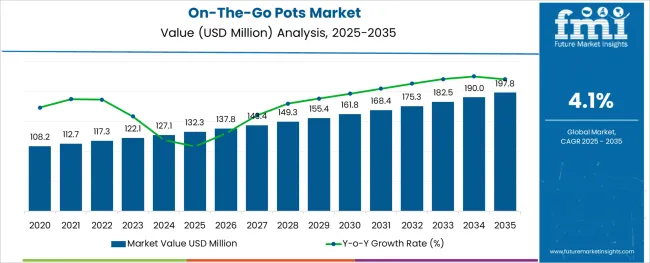
The on-the-go pots market is expanding steadily, fueled by changing consumer lifestyles that emphasize convenience and portability in food packaging. The rise of busy urban populations and increased demand for ready-to-eat meals have driven manufacturers to innovate with compact and durable containers. Material innovations focusing on plastics like polypropylene and low-density polyethylene have supported product durability while maintaining lightweight characteristics.
Retail and foodservice sectors have increasingly adopted medium capacity pots as they provide an optimal balance between portion size and usability. Growing interest in sustainable packaging solutions and regulatory focus on food safety have further influenced product design and adoption.
The market’s outlook remains positive with ongoing shifts toward convenient food consumption patterns, increased snacking culture, and expanding food delivery services. Segment growth is expected to be led by plastic materials, medium capacity containers, and foods as the primary end use.
The market is segmented by Material Type, Capacity Type, and End Use and region. By Material Type, the market is divided into Plastic (PP, LDPE, etc.), Aluminium, Acrylic, and Others. In terms of Capacity Type, the market is classified into Medium (100 grams to 500 grams), Small (20 grams to 100 grams), Large (500 grams to 1000 grams), and Others (>1000 grams).
Based on End Use, the market is segmented into Foods, Beverages, and Cosmetics & Personal Care. Regionally, the market is classified into North America, Latin America, Western Europe, Eastern Europe, Balkan & Baltic Countries, Russia & Belarus, Central Asia, East Asia, South Asia & Pacific, and the Middle East & Africa.
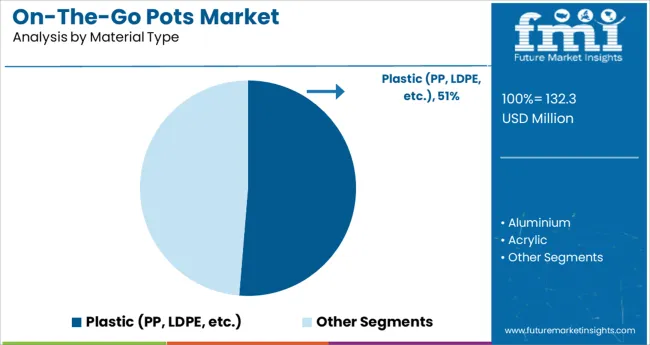
The Plastic segment is projected to hold 51.3% of the on-the-go pots market revenue in 2025, establishing its dominance as the preferred material. This is driven by plastics’ versatility, lightweight nature, and cost efficiency, which suit both manufacturers and consumers seeking practical packaging solutions. Materials like polypropylene and low-density polyethylene offer durability and resistance to moisture, preserving food quality during transport.
Their adaptability to various shapes and sizes also enhances product appeal. Furthermore, ongoing improvements in recyclable and food-grade plastics have increased their acceptance amid growing environmental concerns.
The plastic segment benefits from widespread manufacturing capabilities and supply chain efficiencies, supporting broad market penetration.
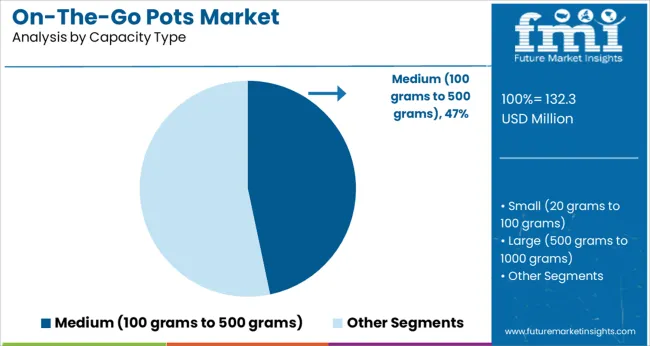
The Medium capacity segment is expected to account for 46.7% of market revenue in 2025, leading other size categories. This segment’s growth is linked to consumer preferences for manageable portion sizes that balance convenience with satisfaction. Medium-sized pots are favored in foodservice and retail for their adaptability to various food types, including snacks, ready meals, and desserts.
The size range caters well to individual consumption patterns and aligns with trends in portion control and on-the-go snacking.
Additionally, manufacturers find medium pots efficient for logistics and storage without compromising product freshness. As demand for single-serve and portable food containers grows, the medium capacity segment is positioned to sustain market leadership.
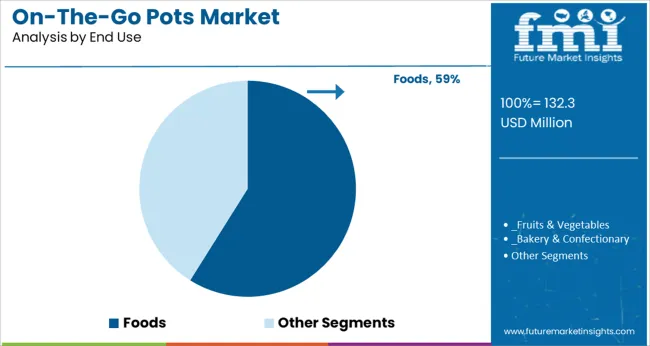
The Foods segment is projected to represent 58.9% of the on-the-go pots market revenue in 2025, maintaining its position as the largest end-use category. The segment’s expansion is attributed to the rising consumption of convenience foods and the growing food delivery ecosystem. Consumers increasingly seek packaging that supports food preservation, ease of transport, and quick consumption, driving demand in the foods sector.
The surge in ready-to-eat meals, meal kits, and healthy snacks has bolstered the need for on-the-go pots that meet hygiene and safety standards.
Additionally, expanding urbanization and changing eating habits have reinforced the importance of portable food containers. As the food industry innovates in product variety and presentation, the foods end-use segment is expected to continue as a major growth driver for on-the-go pots.
Portability and easy handling are important trends driving the sales of on-the-go pots. Adoption of on-the-go pots in the pharmaceutical, healthcare, food & beverage, and personal hygiene sectors increases owing to convenience and re-usability. Evolving and developing customer lifestyles in the thriving economy propels the demand for on-the-go pots.
The presence of several key players in the global market expands the on-the-go pots market size.
Oscillating consumer patterns in purchasing and buying habits in evolving lifestyles escalates the sales of on-the-go pots. The re-closable facility required for medicines such as tablets, syrups, and ointments broadens the global on-the-go pots market share.
The high demand for on-the-go pots by the growing trend of the retail packaging industry contributes to global market growth. Changing lifestyles and a growing population of women in the workforce aid in the expansion of the on-the-go pots market size. The growing landscape of the travel & tourism sector gives rise to the demand for on-the-go pots.
Smart packaging solutions are opted for by manufacturers owing to rapid urbanization elevating the sales of on-the-go pots. Growth and evolution of the beverage industry globally propel the adoption of on-the-go pots.
Transparent or see-through packaging for easy product identification enhances durability and security, thereby increasing the adoption of on-the-go pots. New designs and innovative solutions emerging across developing economies across the world escalate the sales of on-the-go pots. Eye-catching packaging in cosmetics and personal care products augments the beauty industry and elevates the demand for on-the-go pots.
The launch of lucrative packaging such as pouches and wraps as alternative packaging hinders the sales of on-the-go pots. Demand for on-the-go pots might be obstructed due to the weak distribution network of on-the-go products and few modes thereof across developing countries.
High costs associated with on-the-go food products, as opposed to traditional food product packaging, further curbs the adoption of on-the-go pots. Uncertainty created in the market in the consumers’ buying pattern owing to the lockdown restrictions thwarts the expansion of the on-the-go pots market size.
Rising environmental concerns and stringent regulations imposed on the disposal of plastics impede the sales of on-the-go pots. Prices of raw materials for beverage packaging fluctuating in the current economy restrains the growth of the on-the-go pots market size.
Owing to the increasing consumption of dairy-based products, the on-the-go pots market size promises growth. Gifting, bulk orders, and corporate orders are a few of the many strategies that the on-the-go pots market share is implementing to enhance the market.
Manufacturers are innovating compostable and recyclable packaging to gain a competitive edge over other contemporaries to propel the sales of on-the-go pots. To cater to the minimalism trend across the world, manufacturers are developing packaging materials devoid of unnecessary materials and cluttered designs, further bolstering the demand for on-the-go pots.
Brands strengthening their online presence to acquire revenue opportunities via e-commerce and online stores bolsters the on-the-go pots market growth. Meal delivery chains are growing rapidly in economies around the world, demanding more recyclable and biodegradable packaging progresses the on-the-go pots market share.
New product development, as a strategic approach to manufacturing advanced on-the-go food packaging, further increases the adoption of on-the-go pots. Increasing health awareness about non-carcinogenic materials used for food packaging presents lucrative opportunities for manufacturers to develop eco-friendly packaging and further escalates the on-the-go pots market size. Prevailing demand for on-the-go snacks for the busy laborer presents a lucrative scope for manufacturers of the on-the-go pots market share.
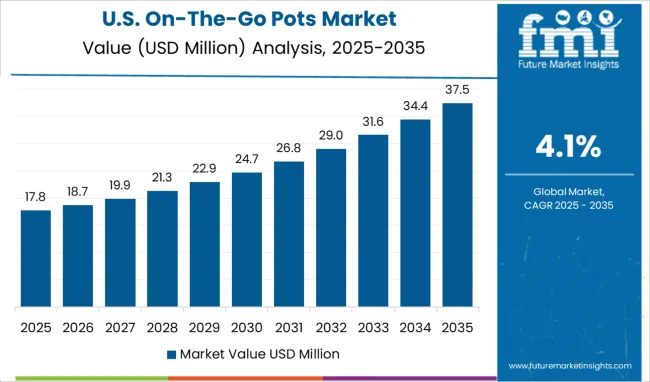
North America is closely following the leading region, accumulating a revenue share of 17% in 2025. Both regions are expected to witness significant growth in the on-the-go pots market share owing to high demands for ready-to-eat packaged food & beverages.
These regions additionally provide better storage, along with warehouse facilities. They further develop materials that accommodate in extending the shelf life of perishable foods and beverages.
The Asia Pacific is anticipated to observe adequate growth owing to the rising popularity of on-the-go pots market trends. The developing economies in this region, resulting in a time crunch amongst the working population, surge demand for on-the-go pots foods and beverages, further propelling the global market growth.
Increasing disposable income, along with the availability of resources at affordable prices owing to rapid urbanisation, boosts the on-the-go pots market share.
Rapidly growing demand for on-the-go products due to a tremendously busy lifestyle increases demand for on-the-go pots packaging. Lack of time to prepare and encase food owing to increasing work hours or managing one’s family contributes to the market growth. However, consumers are opting for packaging that is both sustainable and eco-friendly as a result of environmental degradation.
A lot of start-up companies in the on-the-go pots market share are hence inspired to inculcate the market with the most user-friendly packaging. Around, Fonkels, Onalytics, LaFabrica Craft, Paboco, etc. are amongst a few of the several start-up brands who are implementing various strategies such as zero smart waste containers, disposable packaging, smart keg packaging, paper bottles, etc. to expand and promote market growth.
Some of the key market players in the on-the-go pots market are Joseph Joseph Ltd., MIRON Violettglas BV., Packaging Mode Ltd., Victoria Packaging Ltd., H&K MÜLLER GMBH & CO. KG., Jamestrong Packaging., Berry Plastics, Bemis, Coveris, Amcor Plc, Oracle Packaging, Tetra Pak International S.A., Bericap Holding GmBH, Graham Packaging Company, Sigma Plastics Group, Sonoco Products Company, Sealed Air Corporation, Smurfit Kappa Group, DS Smith Plc, Mondi Group Plc, WestRock Company, International Paper Company, Coveris Holdings S.A., Huhtamäki Oyj, Winpak Ltd., Schur Flexibles Holding GesmbH, Hood Packaging, Novolex, Pregis, Proampac, Scholle IPN, Printpack, 0020Oracle Packaging, WestRock, Winpak, Tetra Laval International S.A., Coveris Holdings S.A., Georgia-Pacific LLC, Linpac Packaging Ltd, Constantia Flexibles Group GmbH, Reynolds Group Holdings Ltd., Clondalkin Group Holdings B.V., Around, Fonkels, Onalytics, LaFabrica Craft, Paboco, etc.
Complying with “Go Green” campaigns around the world, with increasing awareness about environmental issues – key manufacturers are tirelessly working on producing eco-friendly packaging for food, beverage and even cosmetic products. Along with research and development by these brands, celebrity endorsements further contribute in propelling the on-the-go-pots market growth.
Some of the recent developments in the on-the-go pots market are
| Report Attribute | Details |
|---|---|
| Growth Rate | CAGR of 4.1% from 2025 to 2035 |
| Base year for estimation | 2024 |
| Historical data | 2020 to 2024 |
| Forecast period | 2025 to 2035 |
| Quantitative units | Revenue in million and CAGR from 2025 to 2035 |
| Report coverage | Revenue forecast, volume forecast, company ranking, competitive landscape, growth factors, and trends, Pricing Analysis, |
| Segments covered | Types, Application, and Region |
| Regional scope | North America; Western Europe; Eastern Europe; Middle East; Africa; ASEAN; South Asia; Rest of Asia; Australia and New Zealand |
| Country scope | USA, Canada, Mexico, Germany, UK, France, Italy, Spain, Russia, Belgium, Poland, Czech Republic, China, India, Japan, Australia, Brazil, Argentina, Colombia, Saudi Arabia, UAE, Iran, South Africa |
| Key companies profiled | Joseph Joseph Ltd.; MIRON Violettglas BV.; Packaging Mode Ltd.; Victoria Packaging Ltd.; H&K MÜLLER GMBH & CO. KG.; Jamestrong Packaging.; Berry Plastics; Bemis; Coveris; Amcor Plc; Oracle Packaging; Tetra Pak International S.A.; Bericap Holding GmBH; Graham Packaging Company; Sigma Plastics Group; Sonoco Products Company; Sealed Air Corporation; Smurfit Kappa Group; DS Smith Plc; Mondi Group Plc; WestRock Company; International Paper Company; Coveris Holdings S.A.; Huhtamäki Oyj; Winpak Ltd.; Schur Flexibles Holding GesmbH; Hood Packaging; Novolex; Pregis; Proampac; Scholle IPN; Printpack; 0020Oracle Packaging; WestRock; Winpak; Tetra Laval International S.A.; Coveris Holdings S.A.; Georgia-Pacific LLC; Linpac Packaging Ltd; Constantia Flexibles Group GmbH; Reynolds Group Holdings Ltd.; Clondalkin Group Holdings B.V.; Around; Fonkels; Onalytics; LaFabrica Craft; Paboco |
| Customization scope | Free report customization (equivalent to up to 8 analysts working days) with purchase. Addition or alteration to country, regional & segment scope. |
| Pricing and purchase options | Avail customized purchase options to meet your exact research needs. |
The global on-the-go pots market is estimated to be valued at USD 132.3 million in 2025.
It is projected to reach USD 197.8 million by 2035.
The market is expected to grow at a 4.1% CAGR between 2025 and 2035.
The key product types are plastic (pp, ldpe, etc.), aluminium, acrylic and others.
medium (100 grams to 500 grams) segment is expected to dominate with a 46.7% industry share in 2025.






Full Research Suite comprises of:
Market outlook & trends analysis
Interviews & case studies
Strategic recommendations
Vendor profiles & capabilities analysis
5-year forecasts
8 regions and 60+ country-level data splits
Market segment data splits
12 months of continuous data updates
DELIVERED AS:
PDF EXCEL ONLINE
Tamper Evident Pots & Tubs Market
Wax Paper Medicine Pots Market Size and Share Forecast Outlook 2025 to 2035
Pharmaceutical Plastic Pots Market Size and Share Forecast Outlook 2025 to 2035
Digital Potentiometer IC (Digipots) Market

Thank you!
You will receive an email from our Business Development Manager. Please be sure to check your SPAM/JUNK folder too.
Chat With
MaRIA